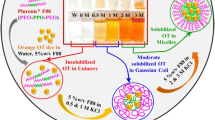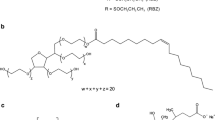Abstract
This study reports the utility of the hydrophobic probe Nile Red (NR) to understand the concentration nduced microenvironmental changes of sodium deoxycholate (NaDC) bile salt from the premicellar to postmicellar range. The spectroscopic properties like absorbance value, fluorescence intensity and fluorescence lifetime of NR are significantly sensitive towards different states of aggregation of NaDC bile salt. The critical aggregation concentrations of different states (dimer to primary micellar aggregates (1.0 mM), secondary micellar aggregates (7.0 mM), and higher micellar aggregates (14 mM)) have been determined from the absorbance value and fluorescence intensity measurements. The ET(30) polarity parameter values suggest a considerable decrease in the micropolarity with an increase in NaDC concentrations. Furthermore, the spectroscopic properties of NR are also sensitive towards the NaCl induced gelation process of NaDC bile salt. Changes in the micropolarity and microviscosity of the NaDC + NaCl mixed system have been estimated using the emission maximum value (cm−1) and fluorescence lifetime values of NR with an increase in the NaCl concentration. Microviscosity of the medium increases from ~19 mPa s to ~26 mPa s from the sol phase to the gel phase. Temperature dependence of both size and phase changes of the NaDC + NaCl (30 mM + 1 M) gel network has been studied using differential scanning calorimetry and dynamic light scattering studies. Temperature induced polarity and microviscosity changes of the NaDC + NaCl (30 mM + 1 M) gel network have also been studied using the fluorescence properties of NR.
Similar content being viewed by others
References
C. J. Drummond and C. Fong, Surfactant self-assembly objects as novel drug delivery vehicles, Curr. Opin. Colloid Interface Sci., 2000, 4, 449–456.
J. C. Shah, Y. Sadhale and D. M. Chilukuri, Cubic phase gels as drug delivery systems, Adv. Drug Delivery Rev., 2001, 47, 229–250.
M.J. Monte, J.J. Marin, A. Antelo and J. Vazquez-Tato, Bile acids: chemistry, physiology, and pathophysiology, World J. Gastroenterol., 2009, 15, 804–816.
N. Pavlović, K. Stankov and M. Mikov, Probiotics–interactions with bile acids and impact on cholesterol metabolism, Appl. Biochem. Biotechnol., 2012, 168, 1880–1895.
M. Stojančević, K. Stankov and M. Mikov, The impact of farnesoid X receptor activation on intestinal permeability in inflammatory bowel disease, Can. J. Gastroenterol., 2012, 26, 631–637.
J. Swain, Molecular level investigation on the interaction of pluronic f127 and human intestinal bile salts using excited state prototropism of 1-naphthol, J. Photochem. Photobiol., B, 2016, 160, 61–67.
K. Matsuoka and Y. Moroi, Micelle formation of sodium deoxycholate and sodium ursodeoxycholate, Biochim. Biophys. Acta, 2002, 1508, 189–199.
U. Subuddhi and A. K. Mishra, Micellization of bile salts in aqueous medium: a fluorescence study, Colloids Surf., B, 2007, 57, 102–107.
M. Mohapatra and A. K. Mishra, 1-Naphthol as a sensitive fluorescent molecular probe for monitoring the interaction of submicellar concentration of bile salt with a bilayer membrane of DPPC, a lung surfactant, J. Phys. Chem. B, 2010, 114, 14934–14940.
Y. Yunomiya, T. Kunitake, T. Tanaka, G. Sugihara and T. Nakashima, Micellization of mixed system of bile salt and nonionic surfactant: sodium deoxycholate and decanoyl- n-methylglucamide, J. Colloid Interface Sci., 1998, 208, 1–5.
D. G. Oakenfull and L. R. Fisher, The role of hydrogen bonding in the formation of bile salt, J. Phys. Chem., 1977, 81, 1838–1841.
M. C. Carey and M. D. Small, Micelle formation by bile salts. physical-chemical and thermodynamic considerations, Arch. Intern. Med., 1972, 130, 506–527.
F. Mustan, A. Ivanova, G. Madjarova, S. Tcholakova and N. Denkov, Molecular dynamics simulation of the aggregation patterns in aqueous solutions of bile salts at physiological conditions, J. Phys. Chem. B, 2015, 119, 15631–15643.
Q. Chai, Y. Jiao and X. Yu, Hydrogels for biomedical applications: their characteristics and the mechanisms behind them, Gels, 2017, 3, 1–15.
R. Li, E. Carpentier, E. D. Newell, L. M. Olague, E. Heafey, C. Yihwa and C. Bohne, Effect of the structure of bile salt aggregates on the binding of aromatic guests and the accessibility of anions, Langmuir, 2009, 25, 13800–13808.
D. Fuentelba, K. Thurber, E. Bovero, T. C. S. Pace and C. Bohne, Effect of sodium chloride on the binding of polyaromatic hydrocarbon guests with sodium cholate aggregates, Photochem. Photobiol. Sci., 2011, 10, 1420–1430.
X. Sun, X. Xin, N. Tang, L. Guo, L. Wang and G. Xu, Manipulation of the gel behavior of biological surfactant sodium deoxycholate by amino acids, J. Phys. Chem. B, 2014, 118, 824–832.
A. Jover, F. Meijide, E. Rodriguez Nunez and J. Vazquez Tato, M. Mosquera and F. Rodriguez Prieto, Unusual pyrene excimer formation during Sodium deoxycholate gelation, Langmuir, 1996, 12, 1789–1793.
A. Y. Jee, S. Park, H. Kwon and M. Lee, Excited state dynamics of Nile red in polymers, Chem. Phys. Lett., 2009, 477, 112–115.
M. M. G. Krishna, Excited-state kinetics of the hydrophobic probe Nile red in membranes and micelles, J. Phys. Chem. A, 1999, 103, 3589–3595.
A. Cser, K. Nagy and L. Biczok, Fluorescence lifetime of Nile red as a probe for the hydrogen bonding strength with its microenvironment, Chem. Phys. Lett., 2002, 360, 473–478.
N. Ghoneim, Photophysics of Nile red in solution steady state spectroscopy, Spectrochim. Acta, Part A, 2000, 56, 1003–1010.
A. G. Gilani, M. Moghadama and M. S. Zakerhamidi, Solvatochromism of Nile red in anisotropic media, Dyes Pigm., 2012, 92, 1052–1057.
R. Saxena, S. Shrivastava, S. Haldar, A. S. Klymchenko and A. Chattopadhyay, Location, dynamics and solvent relaxation of a Nile red-basedphase-sensitive fluorescent membrane probe, Chem. Phys. Lipids, 2014, 183, 1–8.
I. N. Kurniasih, H. Liang, P. C. Mohr, G. Khot, J. P. Rabe and A. Mohr, Nile red dye in aqueous surfactant and micellar solution, Langmuir, 2015, 31, 2639–2648.
C. Lin, J. Zhao and R. Jiang, Nile red probing for the micelle-to-vesicle transition of AOT in aqueous solution, Chem. Phys. Lett., 2008, 464, 77–81.
A. Datta, D. Mandal, S. K. Pal and K. Bhattacharyya, Intramolecular charge transfer processes in confined systems: Nile red in reverse micelles, J. Phys. Chem. B, 1997, 101, 10221–10225.
P. Greenspan, E. P. Mayer and S. D. Fowler, Nile red: a selective fluorescent stain for intracellular lipid droplets, J. Cell Biol., 1985, 100, 965–973.
D. L. Sackett, J. R. Knutson and J. Wolff, Hydrophobic surfaces of tubulin probed by time-resolved and steady –state fluorescence of Nile red, J. Biol. Chem., 1990, 265, 14899–14906.
P. Hazra, D. Chakrabarty, A. Chakraborty and N. Sarkar, Intramoleular charge transfer and solvation dynamics of Nile red in the nanocavity of cyclodextrins, Chem. Phys. Lett., 2004, 388, 150–157.
D. N. Sackett and J. Wolff, Nile red as a polarity-sensitive fluorescent probe of hydrophobic protein surfaces, Anal. Biochem., 1987, 167, 228–234.
N. Sarkar, K. Das, D. N. Nath and K. Bhattacharyya, Twisted charge transfer process of Nile red in homogeneous solution and in faujasite zeolite, Langmuir, 1994, 10, 326–329.
J. F. Deye, T. A. Berger and A. G. Anderson, Nile red as a solvatochromic dye for measuring solvent strength in normal liquids and mixtures of normal liquids with supercritical and near critical fluids, Anal. Chem., 1990, 62, 615–622.
C. Reichardt, Solvatochromic dyes as solvent polarity indicators, Chem. Rev., 1594, 94, 2319–2358.
J. Swain and A. K. Mishra, Nile red fluorescence for quantitative monitoring of micropolarity and microviscosity of pluronic F127 in aqueous media, Photochem. Photobiol. Sci., 2016, 15, 1400–1407.
Th. Forster and G. Z. Hoffmann, Effect of viscosity on the fluorescence quantum yield of some dye systems, J. Phys. Chem., 1971, 75, 63–76.
Author information
Authors and Affiliations
Corresponding author
Additional information
Electronic supplementary information (ESI) available. See DOI: 10.1039/c9pp00293f
Rights and permissions
About this article
Cite this article
Swain, J., Mishra, J., Ghosh, G. et al. Quantification of micropolarity and microviscosity of aggregation and salt-induced gelation of sodium deoxycholate (NaDC) using Nile red fluorescence. Photochem Photobiol Sci 18, 2773–2781 (2019). https://doi.org/10.1039/c9pp00293f
Received:
Accepted:
Published:
Issue Date:
DOI: https://doi.org/10.1039/c9pp00293f




